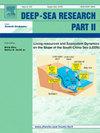Mesoscale cyclonic eddies born in an eastern boundary upwelling system enhance microbial eukaryote diversity in oligotrophic offshore waters
IF 2.3
3区 地球科学
Q2 OCEANOGRAPHY
Deep-sea Research Part Ii-topical Studies in Oceanography
Pub Date : 2024-09-28
DOI:10.1016/j.dsr2.2024.105425
引用次数: 0
Abstract
Mesoscale eddies which originate in Eastern Boundary Upwelling Systems (EBUS) such as the Canary Current System, entrap nutrient-rich coastal water and travel offshore while aging. We have analyzed the protistan plankton community structures in the deep chlorophyll maximum (DCM), sub-DCM, and oxygen minimum zone (OMZ) of three differently aged cyclonic EBUS eddies off Northwest Africa, as well as of non-eddy affected reference sites, using DNA metabarcoding. Throughout all water depths, we found that the investigated eddies generated local dispersal-driven hotspots of protistan plankton diversity in the naturally oligotrophic subtropical offshore waters off Northwest Africa. Based on the taxonomic composition of protistan plankton communities, these diversity hotspots are likely to play an important role in carbon sequestration and for regional food webs up to top predatory levels. Thereby, the life-span of an eddy emerged as an important criterion, how local offshore protistan plankton diversity is transformed quantitatively and qualitatively: each of the three eddies was characterized by notably distinct protistan plankton communities. This could be linked to the physicochemical water properties (predominantly macronutrients, temperature, and salinity) of the eddies' cores and rings, which experience pronounced changes during the eddies’ westward trajectories. Furthermore, we found evidence that eddy-specific deep-water protistan communities are relatively short-lived compared to the ones in the sunlit DCM. However, our results do not only witness from the importance of fine-scale physical ocean features for regional ecosystem processes, but they also show the complexity of these ocean features and that we are still far from understanding the biological processes and their driving forces in such features.
东部边界上升流系统中产生的中尺度气旋漩涡提高了寡营养近海水域微生物真核生物的多样性
源自加那利洋流系统等东部边界上升流系统(EBUS)的中尺度漩涡,在老化过程中会捕获富含营养物质的沿岸水并向近海移动。我们利用 DNA 代谢编码技术分析了西北非附近三个不同老化程度的 EBUS 漩涡的深层叶绿素最高区(DCM)、亚 DCM 和最低含氧区(OMZ)以及未受漩涡影响的参照点的原生浮游生物群落结构。我们发现,在西北非近海天然寡营养亚热带近海水域的所有水深范围内,所调查的漩涡都产生了由扩散驱动的局部原生浮游生物多样性热点。根据原生动物浮游生物群落的分类组成,这些多样性热点可能在碳封存和区域食物网(直至顶级掠食性食物网)中发挥重要作用。因此,漩涡的寿命是一个重要标准,它决定了当地近海原生动物浮游生物多样性如何发生质和量的转变:三个漩涡中的每个漩涡都具有明显不同的原生动物浮游生物群落。这可能与漩涡核心和环的物理化学水属性(主要是大量营养物质、温度和盐度)有关,这些属性在漩涡向西移动的过程中经历了明显的变化。此外,我们发现有证据表明,与日照 DCM 中的原生动物群落相比,漩涡特有的深水原生动物群落寿命相对较短。然而,我们的研究结果不仅证明了细尺度物理海洋特征对区域生态系统过程的重要性,还显示了这些海洋特征的复杂性,以及我们对这些特征中的生物过程及其驱动力的了解还远远不够。
本文章由计算机程序翻译,如有差异,请以英文原文为准。
求助全文
约1分钟内获得全文
求助全文
来源期刊
CiteScore
6.40
自引率
16.70%
发文量
115
审稿时长
3 months
期刊介绍:
Deep-Sea Research Part II: Topical Studies in Oceanography publishes topical issues from the many international and interdisciplinary projects which are undertaken in oceanography. Besides these special issues from projects, the journal publishes collections of papers presented at conferences. The special issues regularly have electronic annexes of non-text material (numerical data, images, images, video, etc.) which are published with the special issues in ScienceDirect. Deep-Sea Research Part II was split off as a separate journal devoted to topical issues in 1993. Its companion journal Deep-Sea Research Part I: Oceanographic Research Papers, publishes the regular research papers in this area.

 求助内容:
求助内容: 应助结果提醒方式:
应助结果提醒方式:


